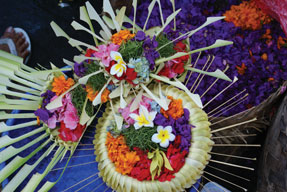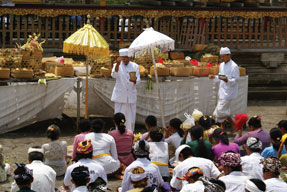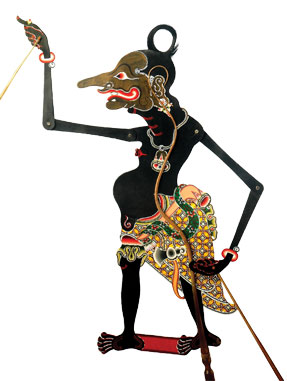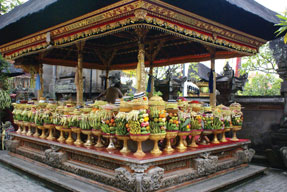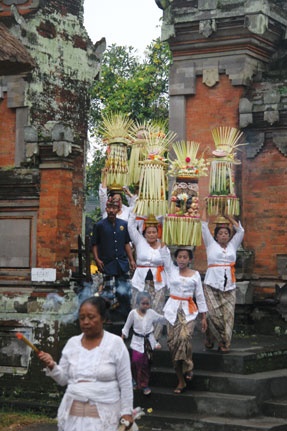Arts
Bedazzled in Bali

Our writer heads to Bali to enjoy the beaches and the verdant rice fields, but finds herself bewitched by the religion of this little island.
|
I open the door of my villa in Ubud, Bali, ready to discover the wonders of this beautiful Indonesian island and then stop. Lying at my feet is a small bamboo basket of beautiful flowers — part rangoli, part pooja offering. That is my introduction to Hinduism in this predominantly Muslim country and I want to know more.
Hinduism came to Bali by invitation. It was not a religion foisted by conquering hordes or unloaded by traders as they exchanged gold for vanilla pods. What the traders brought with them were stories of India’s great Rajas and the Javanese chiefs aspired to emulate the luxurious lifestyle of these kings. There was just one little problem — these simple-minded people were unaware of political machinations and so Brahmin priests were brought in from India to accomplish their goal. As the kings grew stronger, so did Hinduism in the region. This process went on from the 1st century to the 14th century. Buddhism came to Bali and the Majapahit Empire was the strongest and largest. But all this changed in the 15th and 16th century with the advent of Islam in Java and Sumatra. The aristocrats, musicians, artists and learned men fled to Bali to avoid conversion and Bali became what it is even today a veritable fairground of arts and crafts.
I stop to watch an artist at work. As he fills the colors in his painting I am amazed to see the portrait of Goddess Saraswati. The Balinese, the artist tell me, are great followers of this goddess of learning. For Hari Raya Saraswati, or Saraswati Pooja as we know it, offerings are made to books and shrines. I want to know how our great Hindu festivals are celebrated in Bali, but little seems to match. That’s when it dawns on me that Hinduism in Bali is quite unlike the one in India. Here it is mingled with Buddhist beliefs, Chinese influences and the indigenous customs of the Balinese and Javanese. So, when I stop at a temple, I am ready to see something different and different it is. The sound of temple bells is missing, no statues adorn the inner rooms, no diyas light up the darkness and there are no priests handing out prasad. I turn to my guide in confusion and he points out the three courtyards representing Tri Lok, the merus on the temple roof, a reminder of Mt. Meru, the abode of the Gods, and the fact that the temple is dedicated to God Shiva as the Balinese believe in the Holy Trinity of Brahma, Vishnu and Mahesh. But, above all, at the center of their faith of Agama Hindu Dharma is Sangyang Widhiwasa and he is the universal, all embracing God.
Coming from a country with a melee of gods and goddesses, I am still reeling from the intricacies of this religion. But as I tour the town, I see that the religion is vibrant, colorful and very much a daily part of Balinese life. A temple is the place where young girls learn the delicate movements of Balinese dances, where small boys join the gamelan, an ensemble orchestra, where housewives proudly place huge offerings on their head and where men come together to cook the prasad and feast for a temple celebration. But religion is not just confined to temple complexes. Everywhere I turn, I see small shrines — on the side of the road, in rice fields — and all of them have fresh flower offerings in front of them. In fact, virtually every house has a temple complex and every housewife weaves floral offerings each morning using bamboo and fresh flowers. I settle down at a traditional Balinese restaurant for dinner and the kind hostess points out all the dishes that have beef in them. With my choice reduced by a quarter, I try the satay lilit and discover the best satay I have ever encountered, cooked on skewers of fresh lemon
grass over coconut husks. As I step out of the restaurant, I run into a procession and join the crowd of tourists. I figure out that the temple deities are returning after a cleansing bath from a holy spring before the temple anniversary. As the deities enter the temple gates for a welcoming ceremony, I marvel at the calm, radiant faces before me. From the boys carrying flags, the girls bearing heavy offerings of fruits and cakes and the musicians adding a festive air to the proceedings, there is a somber note to the whole affair quite unlike the dancing and loud film music in India. The noisy, jangly sound of the gamelan draws me to a hall where the kecak dance is about to start. As the music of the gamelan dies out, the story of Shri Ram unfolds and I am drawn back to ramlila performances that I used to love as a child. When I go shopping, I realize that married women in Bali wear none of the traditional Hindu symbols that women in India do. But I discover the divine origin of dress in Bali. When Bramha created the world and its people they were naked and Kala the son of Shiva ate them up. The distressed Vishnu met with Indra and they sent some gods and goddesses to earth to civilize people. I buy a beautiful holy water dispenser made of bronze and learn that Brahmin priests used to purify water with ritual prayers before using it for religious ceremonies. I wonder if this is a substitute for gangajal and am told that wealthy Balinese travel on pilgrimage to India to bathe in the Ganges. As I walk around Bali, I discover that I have to constantly hop around to escape offerings laid on the ground. As much as the Balinese believe in gods, they also have great faith in spirits — good and bad. So along with the flower offerings placed out in the mornings, they set out tiny palms leaf trays with rice as offerings to express gratitude to benevolent spirits and placate mischievous demons. Never once during my time in Bali, did I encounter an argument,
a loud discussion or even a mother reprimanding her child. This sense of harmony drives Balinese life, from the design of their house, where the kitchen lies in the south and the temple in the northeast. The concepts of dharma and adharma govern people’s lives in Bali and though the religion is based on the teachings of just two Vedas, the three basic fundamentals: Yadnnya (ceremony), Tatua (philosophy) and Susila (moral behavior) endure. The Hindus in Bali and India traverse the same circle of birth and death, yearning for Moksha (the ultimate release). As I struggle to take in the various elements of a complex religion, I get an SMS from my grandfather, which sets me free. The truth is one, the interpretations multiple.
|

